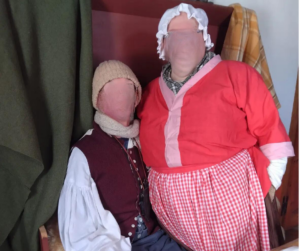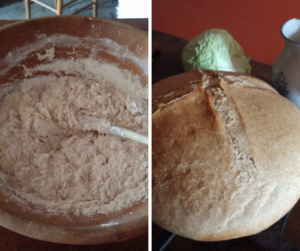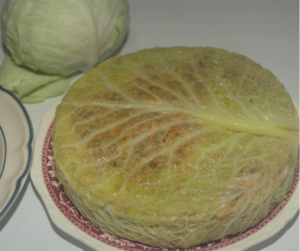TL;DR – I spent the weekend at an 18th century fort, and learned a bit about what I don’t know.

This past weekend, I had the opportunity to present at one of our local 18th century forts. I had a blast, and I got wonderful feedback from the people who came to visit. I was there to do a cooking demonstration, as well as to give people a bit of an idea about what it was like to live in a fort during the French and Indian War. I was set up in the “big house,” or rather the commander’s quarters, along with my partner. We arrived early on Friday afternoon, knowing we’d need to get a good fire going before the sun went down. I wouldn’t say I went into it ignorant, but I really had no idea what I was in for. I had prepared myself mentally for being cold, as the fort is not only without electricity, heat, or running water, it’s also drafty and has a standard 18th century chimney with the flue that yanks all the hot air out. Intellectually, I knew what it was going to be like, and I was more than aware that the night was going to be down to 11F. Intellect does not prepare you for reality, let me just say.

What did I bring with me? Well, I didn’t skimp when it came to modern underpinnings. I had on modern, good quality waffle weave long underwear, and merino wool socks. I had felt slippers that I wore while inside the house, and my modern hiking boots when outside (I don’t yet have appropriate period-accurate footwear for winter use). For at night, I enjoyed snuggling into my military sleep system. I use a British style military folding cot (like this one) which I cover with sheepskins. Over those, I lay a doubled woolen blanket, then my sleep system, and then a nice, thick woolen US Army blanket, regulation green. The temperature inside the house hovered around freezing overnight, possibly a bit below, but not enough to freeze our water jugs through. Outside, it was well below the freezing point, something I was keenly aware of when I had to take the long, brisk walk to the outhouse. I had a cloak to toss over myself, though by mid-day Saturday, I had acclimated to the temperature and didn’t need it.
I was wearing several layers of period correct kit during the day. Over my modern long underwear, I had on a wool chemise with long sleeves, a long sleeve linen dress, a very large kerchief that covered most of my upper body (it’s the black and white check thing you can see at my neck in the picture), and then my bedgown (the red “blouse” I have on). I also had on a thick woolen petticoat and a warm cotton one over top, and then my red checked apron. I enjoyed wearing my fingerless gloves to keep my hands from getting overly cold (though I did a poor job of that). On my head, I wore either my cap (see picture), or a woolen hat, depending on whether I was inside or out. We very carefully closed the kitchen off and stayed there the entire weekend. We set up our cots at night, and stashed them away in a staff-only area during the day. It’s easier to heat a single room. That house would have been impossible to keep warm. As it was, with the fire blazing all day (a totally “white man’s fire” as my partner says), we managed to keep the kitchen in the 40s. Livable, but chilly. Luckily, the fort provides the firewood for us. We went through about a half cord of wood, I’m guessing, just in the three days we were there. We didn’t skimp. Unlike our 18th century ancestors, we do not have brown fat to keep us warm on cold winter nights. My partner has almost no fat at all, and I just have the regular kind. LOL!

I was doing a bread baking demo, among other things. It’s been a while since I made a loaf of bread from scratch, and entirely by hand. It was a good reminder! I started with a wooden bowl, which I oiled well, and then added in my water and yeast, sugar, salt, and a bit more oil. Then I added bread flour, and stirred for a few minutes to incorporate it. I let it sit until it began to bubble, which wasn’t long, and then worked the whole wheat flour in until the dough was soft and silky and smooth. I enjoyed the chance to knead the bread at a correctly sized table (my kitchen has standard counters and I’m a midget, so I’m always hurting my shoulders while kneading). I rose the bread by the fire, the only place in the house warm enough to allow any rise at all. The first rise was not as exciting as I’d hoped it would be, but it did puff up. The second rise was dramatic, however, and then when I baked the bread it turned out perfect.

I also made chou farci (which is a lovely dish which layers cabbage leaves and a meat and barley stuffing, and is then steamed), beef burgundy, and a venison stew. It all turned out very well, and fellow reenactors were thrilled to be invited to eat once the patrons had left.
What did I learn this weekend? This is the point of the post, after all. Everything before this point was just bragging.
I learned that I can deal with cold, if I need to. While I do truly enjoy my 60F room, I can survive just fine when it’s colder than that. I really miss running water, moreso than the electricity and heat. The ability to get at water for washing (myself as well as dishes) and cooking and such is SO important. I learned that I need to moisturize my hands when I’m that cold, because by the time I got home from the event, they were chapped and raw. It’s taken me three full days of constant moisturizing to get them back to normal. I wonder what our ancestors did. I learned that I can bake just fine, even when it’s cold, and that I do like doing so.
I learned that smoke is a reality in fort living. If the fire wasn’t in exactly the right spot, if it shifted even an inch, smoke came into the house instead of going up the flue. It was a constant battle to keep it just right. At one point on Saturday morning, we woke up to the entire house being filled with smoke. We were safe enough; the fire was well contained in the hearth, and held in place by the fire screen. The smoke was billowing into the room, though. I’m still coughing a bit, and it’s several days later.
I would not want to live that way. It was COLD. But I can live that way, and that’s good knowledge to have. Blocking the wind is the important part, and the walls of the fort did a relatively decent job of it. If I were to stay for a longer period at the fort, I’d be putting blankets up over the windows and doors, and the doors to the other parts of the house would NOT be opened until spring. We lost a lot of heat under the interior doors. It was dark inside when we had the window shutters closed, and so we had to choose between warmth and light. That’s a heck of a choice, let me tell you. While we modern people are rich and have the candles and rechargeable solar lights to keep that room lit even in the evening and even when the windows were covered, our ancestors would not have.
I have a much greater understanding of why they went to bed so early. It’s not so much that it’s dark, although that is definitely a part of it. It’s that you’re cold. The blankets keep you warm. Once I was in my sleep system, I was toasty. But after a full day of constant movement and exercise, as well as battling the chill, once that warmth got into me, I was out cold. I slept much longer at the fort than I do when I’m at home. The warmth lulls you.
On Sunday morning, sometime in the wee hours, our fire went out. By the time my alarm went off, it was bitterly cold in the house. My partner, bless his heart, let me stay tucked into my warm bed while he coaxed the fire back to life. I basically peeked my nose and eyes out of my sleep system, and went, “Nope!” I covered myself up and slept for another ten minutes. If I had to live that way, I’d have to set an alarm to make sure that fire NEVER went out. The loss of heat was very noticeable, even though the fire couldn’t have been out for more than an hour or two. It took a good two hours to get the house back up to 40F.
I will be doing this again. I have much to learn about surviving in cold environs. This was a wonderful lesson in what I knew, and what I didn’t know. I highly recommend others give it a try (not necessarily at a fort doing reenacting, but just in general). The biggest thing I learned was that I don’t know what I don’t know. Yes, I had plans to stay warm. No, they didn’t all pan out, because I had to be moving around. It takes actual DOING in order to learn this stuff, and to find the holes in your preparations for cold weather survival.
As an aside, I apologize for not writing in so long. I will try and get here more often!
Hagar

Re. fires at night. I recall reading in a number of places about how important it was to have a “back log,” a large, slow-burning chunk of wood that was reserved for use at night. It was eased into the rear of the fireplace or (later) stove, and burned during the night. If no one woke up to tend the fire, there would at least be sufficient coals to get a breakfast blaze started.
That assumed that you had the right sort of wood, of the proper size, of course.
That is cool! What an experience.
You’re absolutely correct. It is surprising to find out how well you can live without all these luxuries. I am with you, I would not be very happy giving them up, but I also know there is a certain level of inconvenience…hardship… not sure how to describe it, that I can and will tolerate. Like the cold, some smoke, etc…
.
And, you are absolutely correct. Running water trumps them all. Ages ago talking with my Grandmother, I asked here what modern inventions she thought were the most important. I was expecting TV, or radio, some modern kitchen appliance, a washing machine… something like that. Nope, it was indoor plumbing. Top of her list.
It is so easy to take it for granted, and the moment it is gone, it is makes living without lights, internet, or even heat seem like the a piece of cake.
Awesome story, and I”m glad you got the chance to do that! We have a ‘modern’ (1970’s era) fireplace in our house, and depend on it when electric power is out for heat. That happened once this year, and the outside temp ‘only’ dropped to ~20F. I’ll tell you what, I appreciate the modern conveniences. I can do without them, but don’t want to!
Nice article!
The bit about the water jugs not quite freezing reminded me of freeze-proof water storage containers. In boy scouts, we had 5 gallon pails made of canvas, apparently military surplus judging by the color. Just plain canvas, no coating, but they would hold water without any leaks. The reason is that the fibers swell when wetted, so the seams are forced closed. Another nice advantage is that they fold flat when not in use.
Come to think of it, supposedly various Native American tribes have traditions of weaving containers that are similarly tight enough to store liquids. I saw a mention of that in the paper a few weeks ago. O’odham?
Thanks Hagar! This was a good read!